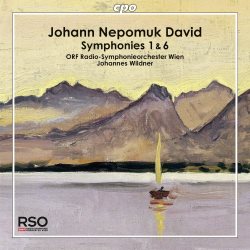| 
|
Johann Nepomuk DAVID (1895-1977)
Symphony No. 1 Op. 18 (1936-7) [29:20]
Symphony No. 6 Op. 46 (1954/66) [30:26]
ORF Radio Symphony Orchestra of Vienna/Johannes Wildner
rec. 14-15 February, 2, 8, 10 March 2011, Grosser Sendesaal, ORF Funkhaus.
CPO 777 741-2 [59.54]
What I like so much about many of CPO’s discs is the supporting commentary. Often at the back of the booklet the main themes of the works presented are given alongside full biographical information and frequently, detailed musical analysis. If this analysis is dry and arid — and that can occur — then most people jump on to the next paragraph or give up on the booklet altogether. In the notes for this disc Bernhard A. Kohl strikes just the right balance.
If you are not familiar with this composer — and I was in a similar boat — then let me offer the following. David thought of Bach as the greatest genius. He was in awe of Brahms and very much of Bruckner, whose corpse he had seen in the crypt of the very church, St. Florian’s in Vienna, where David had sung as a choirboy. He also loved and admired Mahler whose music he conducted. Later he took a strong interest in Schoenberg and twelve-tone technique. Counterpoint, which is such a stylistic trait of David's music, is especially in evidence in the First Symphony.
It might be thought, on reading his biography, that David’s music — he was himself a great analyst — might end up rather dry and colourless but this is certainly not the case. The main melody of the First Symphony — example 1 in the booklet — is clearly in the Dorian mode although the symphony is given as in A minor. What struck me also, especially in the coruscating finale where so many themes intermingle, was the closeness to the highly contrapuntal if slightly unrelenting Scherzo of Rubbra’s Second Symphony of exactly the same year. David’s orchestration however is a little more translucent.
The first movement, the longest, is an Allegro moderato of great vigour and direction. The solid Andante sostenuto is a little lacking in personality but is scored with great clarity and the modal melody is played with in a fascinating way both rhythmically and harmonically. The third movement, a Scherzo, is a brief novelty in 5/8 time, again quite translucent and the aforementioned finale is a rondo, which grows in excitement. I really enjoyed this symphony, as apparently did the first audiences. The composer Jean Absil described its as ‘full of fire”.
Another influence one can detect is that of Hindemith. His shadow reigns over the First Symphony especially the first movement as it does over the Symphony No. 6 but never stiflingly so. The work was much revised twelve years after its first performance with the finale especially altered. This work is, to quote the composer, “festive and exhilarating” and those epithets certainly apply to the first movement, a succinct and powerfully energetic Allegro. The Adagio second movement has a touch of Shostakovich about it and is in three-part arch-form. The Scherzo is a brilliant and quixotic Viennese waltz and the finale a rondo with a double fugue, the second one being slow and reflective.
This time just one basic motif dominates the Symphony throughout. That is the interval of a second followed by a fourth that David uses in multifarious permutations. The ending is a little abrupt but what a technical tour de force and what a fine performance. The same applies to both symphonies. I don’t know how often the ORF Vienna Radio Symphony Orchestra have played these works but under the strong persuasion of Johannes Wildner they sound as if they have performed them all their lives.
I have enjoyed both of these symphonies, which are ideal companions.
Having heard them, I wanted to play them again straightaway which is
a rare feeling. Look out for the next volume, which I believe, is now
‘in the can’.
Gary Higginson
 |
 |
|
